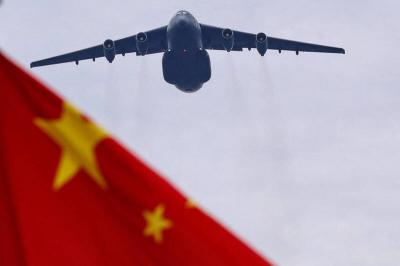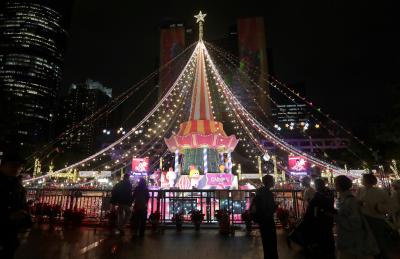The launch of China’s first Type 055 guided missile destroyer on Wednesday marks a significant increase in the threat to Taiwan posed by the Chinese People’s Liberation Army Navy (PLAN), observers in Taiwan said.
At 10,000 tonnes, the destroyers have a large displacement and are believed to possess advanced air defenses, as well anti-submarine and cruise-missile capabilities, they said.
Although it is unlikely that the warships were developed to fight the Taiwanese military, they expose the nation’s east coast — which is studded with military bases — to missile strikes, they added.

Photo: AP
The destroyers are to be the mainstay of the PLAN’s carrier escort fleets. The Soviet-built Liaoning is China’s sole operational carrier, as the PLAN has yet to declare its sister ship, which was launched in April, operational.
Another carrier is under construction.
Due to its small aircraft complement, the Liaoning is adequate for air defense, but not suited for offensive missions, said Chieh Chung (揭仲), a research fellow at the National Policy Foundation, a Chinese Nationalist Party (KMT) think tank.
The small size of the Liaoning’s air wing is the result of inherent design limitations, such as its ski-jump flight deck, he said.
“However, with the deployment of Type 055 destroyers, the Chinese carrier battle group’s ground-attack capabilities are enhanced. For example, a Type 055 destroyer can attack our facilities, such as the Chiashan (佳山) Air Base [in Hualien County], from the far seas to the east by cruise missiles,” Chieh said.
Such attacks would tax the military’s ability to defend the nation, he said.
The best way to counter the new breed of Chinese destroyers is a capable submarine flotilla, Chieh said, adding that the government should find foreign technical assistance to acquire and maintain such assets.
Democratic Progressive Party Legislator Tsai Shih-ying (蔡適應) said the PLAN’s guiding philosophy is to make China a major sea power, and that it has set objectives for the fleet’s immediate, intermediate and long-term futures.
“The PLAN’s objectives are securing its existing maritime interests in the immediate future, extending its sphere of influence to the Taiwan Strait and South China Sea in the interim, then projecting its naval power at the Strait of Malacca in the long-term,” Tsai said.
It is more likely that China is building the new destroyers to fulfill its long-term strategic vision, rather than attacking Taiwan, he said.
However, if China expels the US and its allies from the region and becomes Southeast Asia’s hegemonic power before starting a war against Taiwan, the nation’s ability to resist such an attack would be an open question, he said.
Taiwan needs to have an arsenal of missiles, because the ability to deter or destroy PLAN’s surface combatants in the initial stage of a conflict is crucial to winning a naval battle with China, Tsai said.
“The unit cost of missiles is less than that of submarines. In addition, the latter are far more vulnerable to saturation attacks. Using the Chungshan Institute of Science and Technology to develop mid and long-range missiles that can overcome anti-missile defenses is an option the military should weigh carefully,” he said.
The PLAN’s expansion is likely being carried out to augment China’s regional influence in tandem with its “One Belt, One Road” initiative, rather than to attack Taiwan, an unnamed Ministry of National Defense official said.
As the destroyers become a mainstay of Chinese surface fleets, they will boost the PLAN’s anti-air capability and its munition payloads, the official said.
However, sheer tonnage does not have a direct correlation with combat capabilities, and the Taiwanese navy’s Touchiang-class corvettes and missiles should be capable of countering the Chinese destroyers, the official said.

Beijing could eventually see a full amphibious invasion of Taiwan as the only "prudent" way to bring about unification, the US Department of Defense said in a newly released annual report to Congress. The Pentagon's "Annual Report to Congress: Military and Security Developments Involving the People's Republic of China 2025," was in many ways similar to last year’s report but reorganized the analysis of the options China has to take over Taiwan. Generally, according to the report, Chinese leaders view the People's Liberation Army's (PLA) capabilities for a Taiwan campaign as improving, but they remain uncertain about its readiness to successfully seize

Taiwan is getting a day off on Christmas for the first time in 25 years. The change comes after opposition parties passed a law earlier this year to add or restore five public holidays, including Constitution Day, which falls on today, Dec. 25. The day marks the 1947 adoption of the constitution of the Republic of China, as the government in Taipei is formally known. Back then the Chinese Nationalist Party (KMT) governed China from Nanjing. When the KMT, now an opposition party in Taiwan, passed the legislation on holidays, it said that they would help “commemorate the history of national development.” That

Taiwan has overtaken South Korea this year in per capita income for the first time in 23 years, IMF data showed. Per capita income is a nation’s GDP divided by the total population, used to compare average wealth levels across countries. Taiwan also beat Japan this year on per capita income, after surpassing it for the first time last year, US magazine Newsweek reported yesterday. Across Asia, Taiwan ranked fourth for per capita income at US$37,827 this year due to sustained economic growth, the report said. In the top three spots were Singapore, Macau and Hong Kong, it said. South

Snow fell on Yushan (Jade Mountain, 玉山) yesterday morning as a continental cold air mass sent temperatures below freezing on Taiwan’s tallest peak, the Central Weather Administration (CWA) said. Snowflakes were seen on Yushan’s north peak from 6:28am to 6:38am, but they did not fully cover the ground and no accumulation was recorded, the CWA said. As of 7:42am, the lowest temperature recorded across Taiwan was minus-5.5°C at Yushan’s Fengkou observatory and minus-4.7°C at the Yushan observatory, CWA data showed. On Hehuanshan (合歡山) in Nantou County, a low of 1.3°C was recorded at 6:39pm, when ice pellets fell at Songsyue Lodge (松雪樓), a